Closed-Loop Lifecycle Management of Service and Product in the Internet of Things: Semantic Framework for Knowledge Integration
Abstract
:1. Introduction
2. State-of-the-Art and Methods
- What is a Product-Service (PS)?
- Which approaches were already tackled as for the ontology-based PLM?
- Which mechanism of IoT message transfer will best fit our needs?
2.1. Product, Service and Product-Service System
- Product-Service (PS): an integrated combination of tangible products and intangible services.
- Product-Service System (PSS): social systems that enhance social and economic value received by each actor in the network through the mutual provision of a PS.
- Actor: an individual, group or organization that is actively engaged in the PSS (e.g., provider, partner or customer).
- The sale of the use of the product instead of the product itself.
- The change to a ‘leasing society’.
- The substitution of goods by means of service machines.
- A repair-society instead of a throw-away society.
- The change in consumer attitudes from sales to service orientation.
- Service at the point of sale, comprised of personal assistance in shops, financial schemes, provided to customers, explanations about product use and, of course, marketing.
- The category of product use: use oriented, where the user extracts product utility; and result oriented, where product utility is extracted by the utility provider.
- Maintenance services include servicing of products with the goal of prolonging the product life cycle, comprising maintenance and upgrading.
- The importance of upgrading services aiming at closing the product material cycle by taking products back, secondary utilization of usable parts in new products and recycling of materials if reuse is not feasible.
- A service offering by manufacturing companies might be a source of continuous revenue as a result of long-term relationships with customers.
- It is a differentiator for competing in global market.
- It gives the capability to offer a flexible value proposition to customers throughout the lifetime of a product.
2.2. Ontology and Semantic Modelling for Product-Lifecycle Management
- Ontologies are models of reality: This is the most classical point of view from which the word ‘ontology’ was understood.
- Ontologies are models of information: According to this view, the ontology itself means the information representation of a given domain problem. In this case, it is possible that such an information model is not a model of any reality.
- Ontologies are compendia of controlled terms: In this view, the use of ontology for defining terms and relationships is importantly underlined in order to define the above-mentioned models. The clear definition of relationships makes terms accessible and useful when they are retrieved.
2.3. Internet of Things and Semantic Modelling Approach
- Semantics for interoperability: This means that different stakeholders can access and interpret the data unambiguously. Things on the IoT need to exchange data with each other and with other users on the Internet. Semantic annotation of the data can provide machine-interpretable descriptions about what the data represent, where they originate from, how they can be related to the surroundings, who is providing them and what are the quality, technical and non-technical attributes.
- IoT data integration: IoT data usually originate from a device or a human and refer to the attributes of a phenomenon or an entity in the physical world. The data can be combined with other data to create different abstractions of the environment or they can be integrated into the data processing chain in and existing application to support context and situation awareness. Semantic descriptions can support this integration by enabling interoperability between different sources.
- Resource/service search and discovery: In the IoT, a resource is referred to as a device or entity that can provide data or perform actuation (e.g., a sensor or an actuator), and a service is a software entity that exposes the functionality of its corresponding resource. The search and discovery mechanisms allow locating resources or services that provide data related to an entity of interest in the physical world. Semantically-annotated data and apps can be processed by and retrieved by intelligent reasoning tools, therefore giving the possibility of integrating an e-ecosystem layer for smart search and knowledge retrieval.
2.4. Open Messaging Interface/Open Data Format: The Open Group IoT Standards for Message Synchronization and Semantic Integration
- Possible to implement for any kind of instance as independently of the application domain as possible.
- Possible to implement for any kind of information system, including embedded and mobile systems.
- Support for ‘synchronous’ messaging, such as immediate read and write operations, including ‘client-poll’ subscriptions.
- Not restricted to one communication protocol only; it must be possible to send messages using protocols, such as plain HTTP, Simple Object Access Protocol (SOAP), simple Mail Transfer Protocol (SMPT), as file copies, etc.
- Possible to create ad hoc, loosely-coupled tie to limited information flows on the fly.
- Peer-to-peer communication possibility for all devices, i.e., client and server functionality can be implemented for any device, depending on available processing power, network, connectivity, etc.
- Handling mobility and intermittent network connectivity, i.e., support for asynchronous messaging capabilities that imply for instance message persistence, time-to-live, etc.
- Context-dependent discovery of instances, instance-related services and meta-data about them.
- Support for context and domain-specific ontologies.
- Queries by regular expression for retrieving information about more than one instance and more than one kind of information.
- Historical queries, i.e., retrieving values between two points in time.
- Support for context and domain-specific ontologies is an important point for the purpose of integrating several domain problems into a global point of view.
- The query possibility is a mandatory factor with the aim of knowledge extraction.
- The possibility of specifying time ranges is useful so that knowledge inference can occur while including temporal constraints. This function helps improve the quality of data search.
3. Semantic Framework for CL2M of Product-Service in IoT: Conceptual Architecture
3.1. Service Upper Ontology and Service Lifecycle Ontology
3.2. Service and Product-Service
3.3. Semantic Info-Node Agent Architecture in an Executable Instance of Framework
- CumulusRDF is an RDF store on a cloud-based architecture, fully compatible with the Sesame APIs. CumulusRDF provides a REST-based API with create, read, update, delete (CRUD) operations to manage RDF data. The current version uses Apache Cassandra as the storage backend.
- Sesame Adapter for Oracle Database: an Oracle-developed adapter component for accessing Oracle Semantic Technologies via the Sesame APIs.
- Strabo is a geospatial RDF triple store based on Sesame.
- Virtuoso Sesame Provider is an OpenLink-developed component that allows accessing an OpenLink Virtuoso triple store via the Sesame APIs.
4. Electric Car and Battery Lifecycle: Case Study on Domain-Specific Ontology Creation
4.1. Domain-Specific Ontology Model
4.1.1. Car and Client Classes
4.1.2. Actor Class
4.1.3. Electric Car Services Class and Relations
- Maintenance: Regular maintenance performed by a technician. We assume a maintenance service is performed every year from the date of purchase of the car during the service contract period.
- Battery exchange: Battery exchange, i.e., swapping, is an alternative to recharging and concerns swapping a drained or nearly drained battery with a fully-charged battery, which is operated in battery exchange stations.
- Battery recycling: This service concerns the recycling of old batteries either after swapping or after complete change.
- Software update: A software update is offered to the client, at a relevant moment, by the car manufacturer. Since it is not mandatory, the client can choose whether to install it or not.
- perform: Which service is performed (e.g., a maintenance)?
- performed_by: By whom is the service performed (e.g., a technician)?
- performed_for: For whom is the service performed (e.g., a private client)?
- performed_in: Where is the service location (e.g., a maintenance centre)?
- performed_on: On which product is the service performed (e.g., a battery or a structure)?
4.2. Data Retrieval Example
SELECT ?service_performed ?service_date
WHERE{
?who a tes:private.
?who tes:private_name ?private_name.
?service_performed tes:performed_for ?who.
?service_performed tes:service_date ?service_date.
FILTER (?private_name="alexandre grozel"^^xsd:string)
}
ORDER BY ?service_date
|
SELECT ?service_performed ?service_date ?battery_exchange_old_battery ?battery_exchange_new_battery ?center ?technician
WHERE{
?service_performed a tes:battery_exchange.
?service_performed tes:performed_for ?private.
?private tes:private_name ?private_name.
?service_performed tes:service_date ?service_date.
?service_performed tes:battery_exchange_old_battery ?battery_exchange_old_battery.
?service_performed tes:battery_exchange_new_battery ?battery_exchange_new_battery.
?service_performed tes:performed_by ?technician.
?service_performed tes:performed_in ?center.
FILTER (?private_name="alexandre grozel"^^xsd:string)
}
|
5. Discussion
- How does the framework enhance information extraction in the context of the product-service lifecycle?
- What are the benefits from the extension of PLM SOM in view of modelling integrated PSLO?
- What are the limitations to be improved?
5.1. How Does the Framework Enhance Information Extraction in the Context of Product-Service Lifecycle?
- Define a new inferred class ‘Battery_Drawback’: as for the category of batteries to examine, we assume that the manufacturer wants to retrieve all of the batteries manufactured before a given date (24 September 2011, for example) for which the battery wear level has been marked as below 70 (which might be an imaginary thread value for functional check).
- Find all of the cars on which those batteries were installed.
- Find all of the customers who had used, or have been using, the car, as well as the service offering associated with the car, if applicable.
- Define a new inferred class ‘Future_Contact’ as a potential service user group, while categorizing those customers into the future group of service clients, and save them in the knowledge base.
- Find all of the services associated with this battery
- Find product the design documents of the battery: for the purpose of retrieving the design information during the beginning-of-life of the product
5.2. What Are the Benefits from the Extension of PLM SOM in View of Modelling Integrated PSLO?
5.3. What Are the Limitations to Be Improved?
- Semantics for each term should be defined properly to avoid ambiguity between stakeholders, including not only researchers, but also industries: For the moment, the community demonstrated very few efforts in standardization. The same authors envision that the terminologies proposed within the domain of PS and PSS will increase exponentially in the forthcoming years. A common vocabulary in PSS should be established rapidly in order for a semantic approach to be widely accepted as a sharable way of dealing with cross-domain product-service lifecycle management.
- A common software platform and methodology needs to be developed to update the ontology in a progressive way. Current IoT-related open platforms and data communication standards might be valuable to enable such a common platform.
- A PSS ontology should be intuitive so that it could be easily and appropriately implemented in industries: we need joint work efforts with the domain specialists and research results from the PSS design and methodologies: A more flexible and modular approach will fit better rather than sticking to a conventional approach to a hard-wired closed platform.
6. Conclusions
6.1. Contribution of Our Approach to PLM and IoT and How It Complements Traditional Approaches
6.2. Research Findings
- (1)
- The use of RDF/XML and OWL2 as the data content in O-MI/O-DF allows broadening the scope of transferred information. The traditional sensor data transfer mainly concerned the product state information assigned to attributes, e.g., temperature or state, or maintenance data, whereas now, the IoT data can even include the object properties (i.e., semantic relations) between IoT or even rule contents. Some such examples include: the battery “was detached from the car”, an owner “purchased a car”, and so on. All information can be exchanged using the same message envelope. It turned out that the semantic framework gives a chance to enlarge the knowledge content available for enhanced PLM.
- (2)
- The horizontal linking of data silos is realized while relevantly establishing object level relations. Not only breaking the vertical silos, our approach makes it possible to achieve flexible evolution in the whole PSS. This is due to the fact that the RDF data can transfer the new class before gathering real IoT data or, inversely, new types of data can be transferred without specifically mentioning the category. The knowledge inference is nonetheless possible by relevantly using semantic rules in OWL2 and SPARQL.
- (3)
- As far as the type of databases is concerned, an RDF database provides a convenient environment for the purpose of populating semantically-annotated IoT data. Otherwise, an additional translation step is required in order to convert the semantic annotation into other serialization formats usually accepted by O-MI/O-DF nodes. Another possible case concerns the IoT data written in XML Schema, whereas the product-service ontology should receive those data for knowledge inference. In this case, the necessary step requires data conversion from usual XML Schema format data into the ontology-fitted RDF version.
6.3. What Is the Near Future Development?
6.4. Concluding Remarks
Acknowledgments
Author Contributions
Conflicts of Interest
Abbreviations
| CL2M | Closed-Loop Lifecycle Management |
| PSS | Product-Service System |
| IoT | Internet of Things |
| URI | Uniform Resource Identifier |
| PLM | Product Lifecycle Management |
| BOL | Beginning of Life |
| MOL | Middle of Life |
| EOL | End of Life |
| O-MI | Open Messaging Interface |
| O-DF | Open Data Format |
| SPARQL | SPARQL (or Simple) Protocol And RDF Query Language |
| SPIN | SPARQL Inferencing Notation |
Appendix A. Example O-DF Message Structure
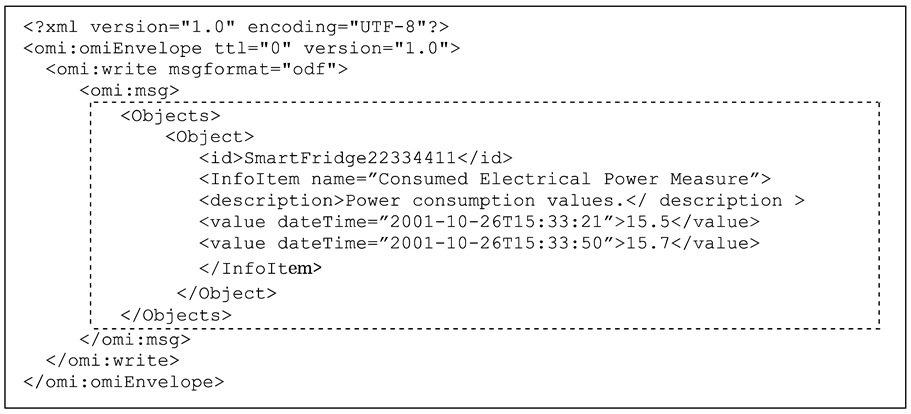

References
- Kiritsis, D. Semantic technologies for engineering asset life cycle management. Int. J. Prod. Res. 2013. [Google Scholar] [CrossRef]
- Matsokis, A. An Ontology-Based Approach for Closed-Loop Product Lifecycle Management. Ph.D. Thesis, Swiss Federal Institute of Technology (EPFL), Lausanne, Switzerland, 2010. [Google Scholar]
- Matsokis, A.; Kiritsis, D. An ontology-based approach for production lifecycle management. Comput. Ind. 2010, 61, 787–797. [Google Scholar]
- Wang, W.; Barnaghi, P. Semantic annotation and reasoning for sensor data. In Smart Sensing and Context; Springer LNCS: Berlin, Germany; Heidelberg, Germany, 2009; Volume 5741, pp. 66–76. [Google Scholar]
- Compton, M.; Barnaghi, P.; Bermudez, L.; García-Castro, R.; Corcho, O.; Cox, S.; Graybeal, J.; Hauswirth, M.; Henson, C.; Herzog, A.; et al. The SSN ontology of the W3C semantic sensor network incubator group. Web Semant. Sci. Serv. Agents World Wide Web 2012, 17, 25–32. [Google Scholar] [CrossRef] [Green Version]
- Romer, K.; Bimschas, D.; Kleine, O.; Mietz, R.; Truong, C.; Hasemann, H.; Kröller, A.; Pagel, M.; Hauswirth, M.; Karnstedt, M.; et al. SPITFIRE: Toward a Semantic Web of Things. IEEE Commun. Mag. 2011, 11, 40–48. [Google Scholar]
- Kley, F.; Lerch, C.; Dallinger, D. New business models for electric cars—A holistic approach. Energy Policy 2011, 30, 3392–3403. [Google Scholar] [CrossRef]
- Nemoto, Y.; Akasaka, F.; Shimomura, Y. A framework for managing and utilizing Product-Service System design knowledge. In Production Planning & Control; Taylor & Francis: Abingdon, UK, 2015. [Google Scholar]
- Mont, O.K. Clarifying the concept of Product-Service System. J. Clean. Prod. 2002, 10, 237–245. [Google Scholar] [CrossRef]
- Peruzzini, M.; Germani, M.; Marilungo, E. Product-service lifecycle management in manufacturing: An industrial case study. In Proceedings of the International Conference on Product Lifecycle Management, Yokohama, Japan, 7–9 July 2014.
- Aurich, J.C.; Fuchs, C.; Wagenknecht, C. Life cycle oriented design of technical Product-Service Systems. J. Clean. Prod. 2006, 14, 1480–1494. [Google Scholar] [CrossRef]
- Gaiardelli, P.; Resta, B.; Martinez, V.; Pinto, R.; Albores, P. A classification model for product-service offerings. J. Clean. Prod. 2014, 66, 507–519. [Google Scholar] [CrossRef]
- Vijaykumar, G.; Roy, R.; Lelah, A.; Brissaud, D. A Review of Product-Service Systems Design Methodologies. J. Eng. Des. 2012, 23, 635–659. [Google Scholar]
- Sriram, R.D.; Bock, C.; Neuhaus, F.; Wallace, E.; Brady, M.; Musen, M.A.; Luciano, J.S. NIST Workshop on Ontology Evaluation; NIST Interagency Internal Report (NISTIR 7774); National Institute of Standards and Technology: Gaithersburg, MD, USA, 2007. [Google Scholar]
- Gucer, V. 5 Things to Know about Semantic Technologies, IBM White Paper. Available online: https://www.ibm.com/developerworks/community/blogs/5things/entry/5_things_to_know_about_the_semantic_technologies?lang=en (accessed on 5 July 2016).
- McGuinness, D.L.; Fikes, R.; Rice, J.; Wilder, S. An Environment for Merging and Testing Large Ontologies. In Proceedings of the Seventh International Conference on Principles of Knowledge Representation and Reasoning (KR2000), Breckenridge, CO, USA, 12–15 April 2000.
- RDF. Resource Description Framework. Available online: https://www.w3.org/RDF/ (accessed on 30 March 2016).
- RDFS. RDF Schema 1.1. Available online: https://www.w3.org/TR/rdf-schema/ (accessed on 30 March 2016).
- OWL 2. Web Ontology Language. Available online: https://www.w3.org/TR/owl2-overview/ (accessed on 30 March 2016).
- SPARQL. Query Language for RDF. Available online: http://www.w3.org/TR/rdf-sparql-query/ (accessed on 30 March 2016).
- SWRL. Semantic Web Rule Language. Available online: http://www.w3.org/Submission/SWRL/ (accessed on 30 March 2016).
- JESS. Rule Engine for the Java Platform. Available online: http://www.jessrules.com (accessed on 30 March 2014).
- Yoo, M.-J.; Um, J.; Stroud, I.; El Kadiri, S.; Kiritsis, D. Integration of Design Intent during the Product Lifecycle Management. In Proceedings of the International Conference Product Lifecycle Management, Yokohama, Japan, 7–9 July 2014.
- Kiritsis, D. Closed-Loop PLM for intelligent products in the era of the Internet-Of-Things. Comput.-Aided Des. 2011, 43, 479–501. [Google Scholar] [CrossRef]
- PROMISE—PROduct Lifecycle Management and Information Tracking Using Smart Embedded Systems. Research Deliverable 9.2. 2009. Available online: http://www.promise.no/downloadfile.php?i =69adc1e107f7f7d035d7baf04342e1ca (accessed on 12 December 2014).
- Barnaghi, P.; Wang, W.; Henson, C.; Taylor, K. Semantics for the Internet of Things: Early progress and back to the future. Int. J. Semant. Web Inf. Syst. (IJSWIS) 2012, 8. [Google Scholar] [CrossRef]
- Qualls, J.; Russomanno, D. Ontological Problem-Solving Framework for Dynamically configuring sensor systems and algorithms. Sensors 2011, 11, 3177–3204. [Google Scholar] [CrossRef] [PubMed]
- O-MI. Open Messaging Interface; The Open Group Standard for the Internet of Things; The Open Group, Open Platform3 Forum: London, UK, 2016; ISBN 1-937218-60-7.
- O-DF. Open Data Format; The Open Group Standard for the Internet of Things; The Open Group, Open Platform3 Forum: London, UK, 2014; ISBN 1-937218-59-1.
- Främling, K.; Kubler, S.; Buda, A. Universal Messaging Standards for IoT from a Lifecycle Management Perspective. IEEE Internet Things J. 2014, 1, 319–327. [Google Scholar] [CrossRef]
- The Open Group (TOG). Available online: http://www.opengroup.org/ (accessed on 30 March 2016).
- Internet of Things Workgroup, Open Group. Available online: http://www.opengroup.org/getinvolved/workgroups/iot (accessed on 30 March 2016).
- JSON. JavaScript Object Notation. Available online: http://www.json.org (accessed on 30 March 2016).
- Kubler, S.; Yoo, M.-J.; Cassagnes, C.; Främling, K.; Kiritsis, D.; Skilton, M. Opportunity to Leverage Information-as-an-Asset in the IoT—The road ahead. In Proceedings of the 3rd International Conference on Internet of Things and Cloud (FiCloud), Rome, Italy, 24–26 August 2015.
- Protégé Ontology Editor. Available online: http://protegewiki.stanford.edu/wiki/Main_Page (accessed on 30 March 2016).
- Wuest, T.; Hribernik, K.; Thoben, K.D. Assessing servitisation potential of PLM data by applying the product avatar concept. Prod. Plan. Control Manag. Oper. 2015. [Google Scholar] [CrossRef]
- Yang, L.; Xing, K.; Lee, S.H. Framework for PSS from Service’ Perspective. In Proceedings of the International multiconference of Engineers and Computer Scientists 2010, Hong Kong, China, 17–19 March 2010.
- Cherubini, S.; Iasevoli, G.; Michelini, L. Product-Service Systems in the electric car industry: Critical success factors in marketing. J. Clean. Prod. 2015, 97, 40–49. [Google Scholar] [CrossRef]
- Pellet. Available online: https://www.w3.org/2001/sw/wiki/Pellet (accessed on 30 March 2016).
- Vezzoli, C.; Ceschin, F.; Diehl, J.C.; Kohtala, C. New design challenges to widely implement Sustainable Product-Service Systems. J. Clean. Prod. 2015, 97, 1–12. [Google Scholar] [CrossRef] [Green Version]
- Dong, M.; Yang, D.; Su, L. Ontology-based service product configuration system modeling and development. Expert Syst. Appl. 2011, 38, 11770–11786. [Google Scholar] [CrossRef]
- Sesame. Available online: http://rdf4j.org (accessed on 30 March 2016).
- Wooldridge, M. An Introduction to Multiagent Systems, 2nd ed.; Wiley: New York, NY, USA, 2009. [Google Scholar]
- Perera, C.; Zaslavsky, A.; Christen, P.; Georgakopoulos, D. Context Aware Computing for The Internet of Things: A Survey. IEEE Commun. Surveys Tutor. 2014, 16, 414–454. [Google Scholar] [CrossRef]
- Yagües-Gomà, M.; Olivella-Rosell, P.; Villafafila-Robles, R.; Sumper, A. Ageing of Electric Vehicle Battery considering Mobility Needs for Urban Areas. In Proceedings of the International Conference on Renewable Energies and Power Quality (ICPREPQ ’14), Cordoba, Spain, 8–10 April 2014.
- Moon, S.K.; Simpson, T.W.; Shu, J.; Kumara, S.R.T. Service representation for capturing and reusing design knowledge in product and service families using object-oriented concepts and an ontology. J. Eng. Des. 2009, 20, 413–431. [Google Scholar] [CrossRef]
- Sun, Y.; Jara, A. An extensible and active semantic model of information organizing for the Internet of Things. Pers. Ubiquitous Comput. 2015, 18, 1821–1833. [Google Scholar]
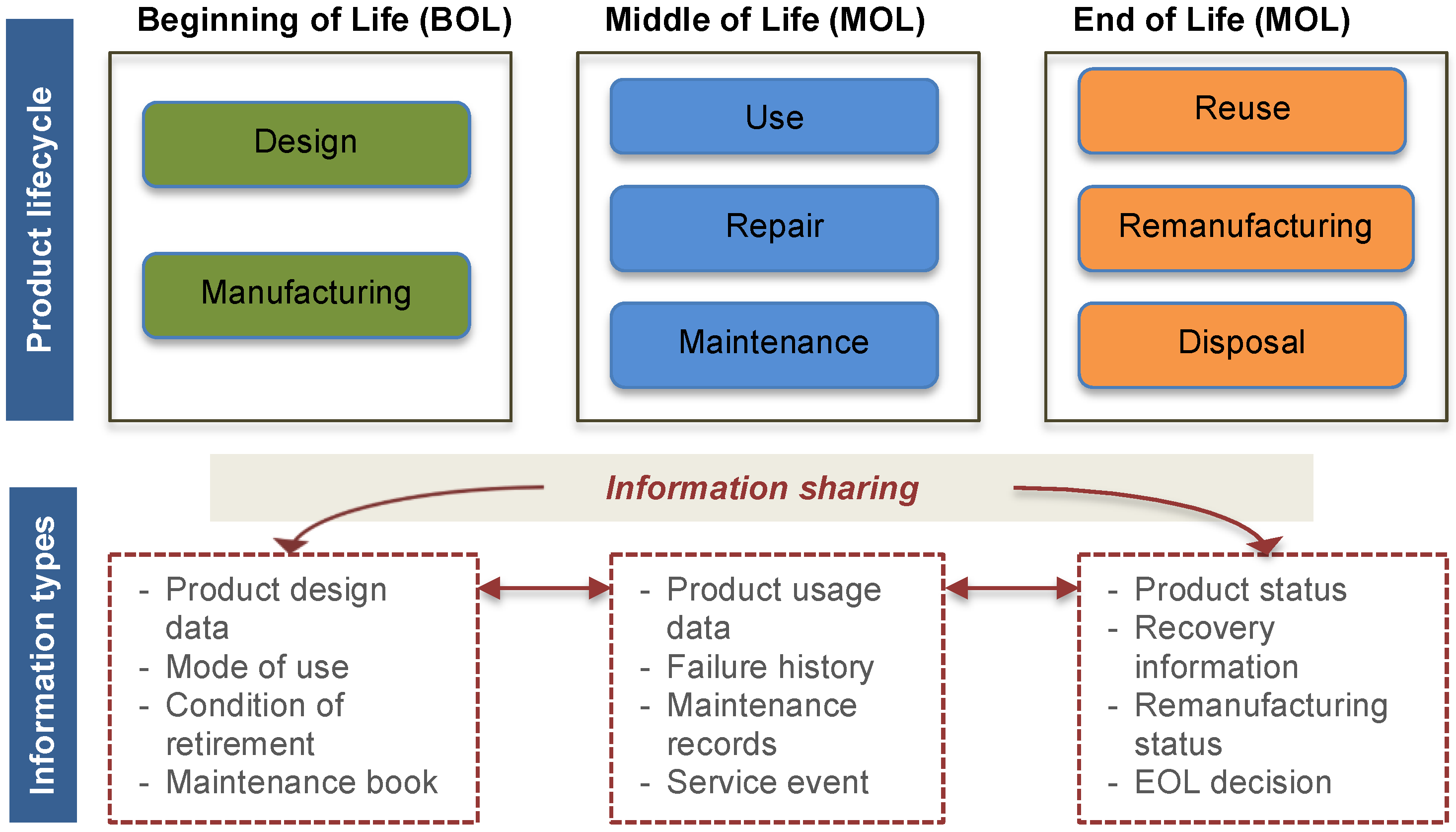

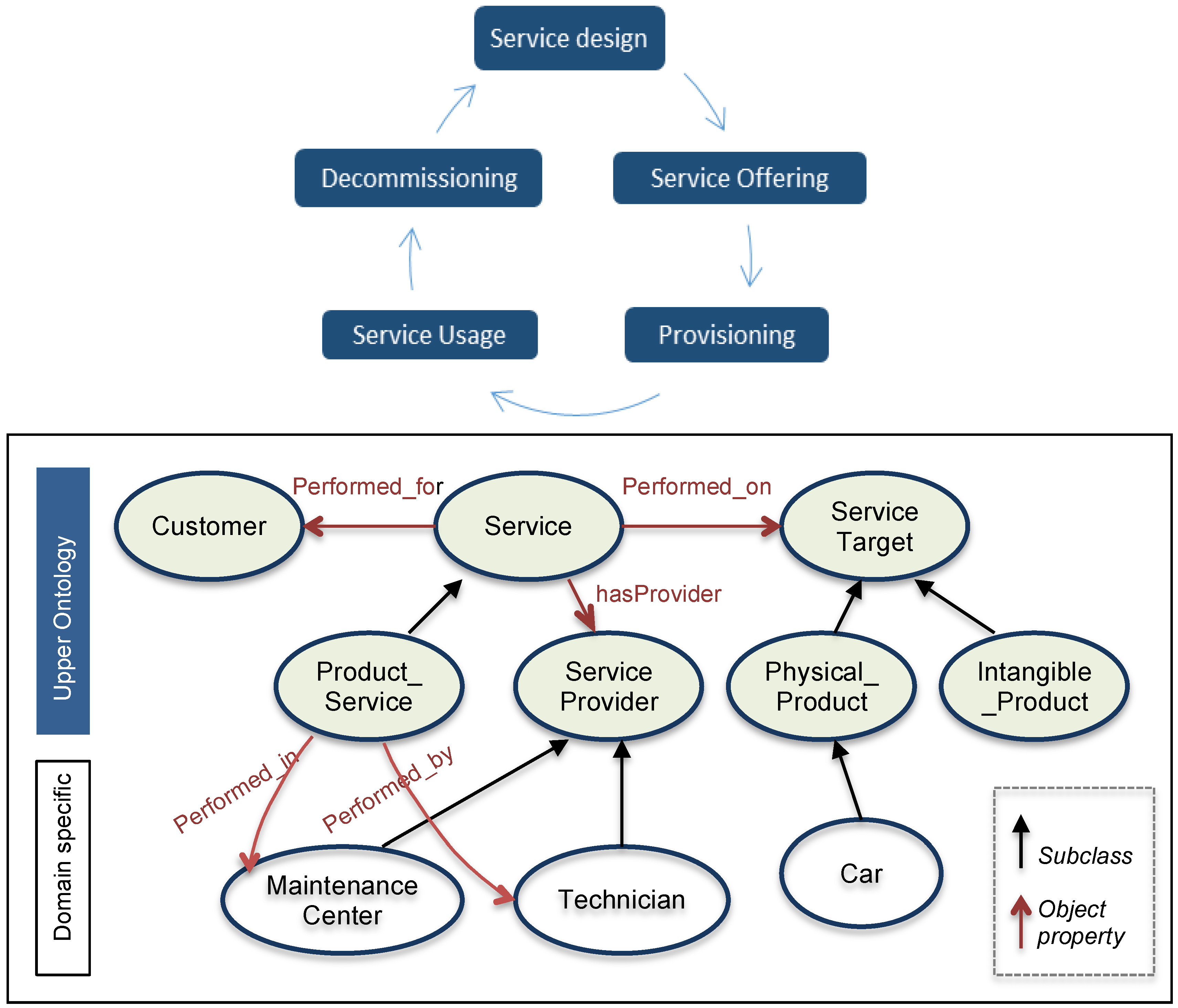
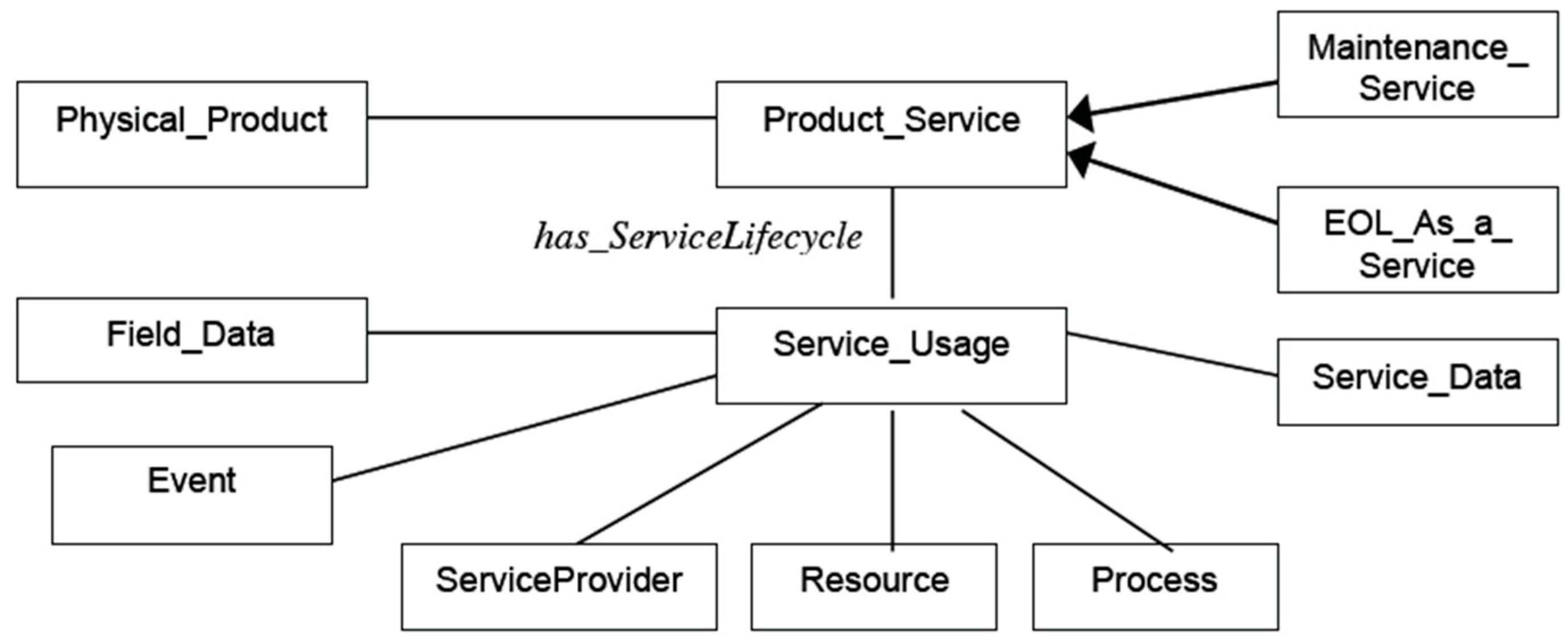
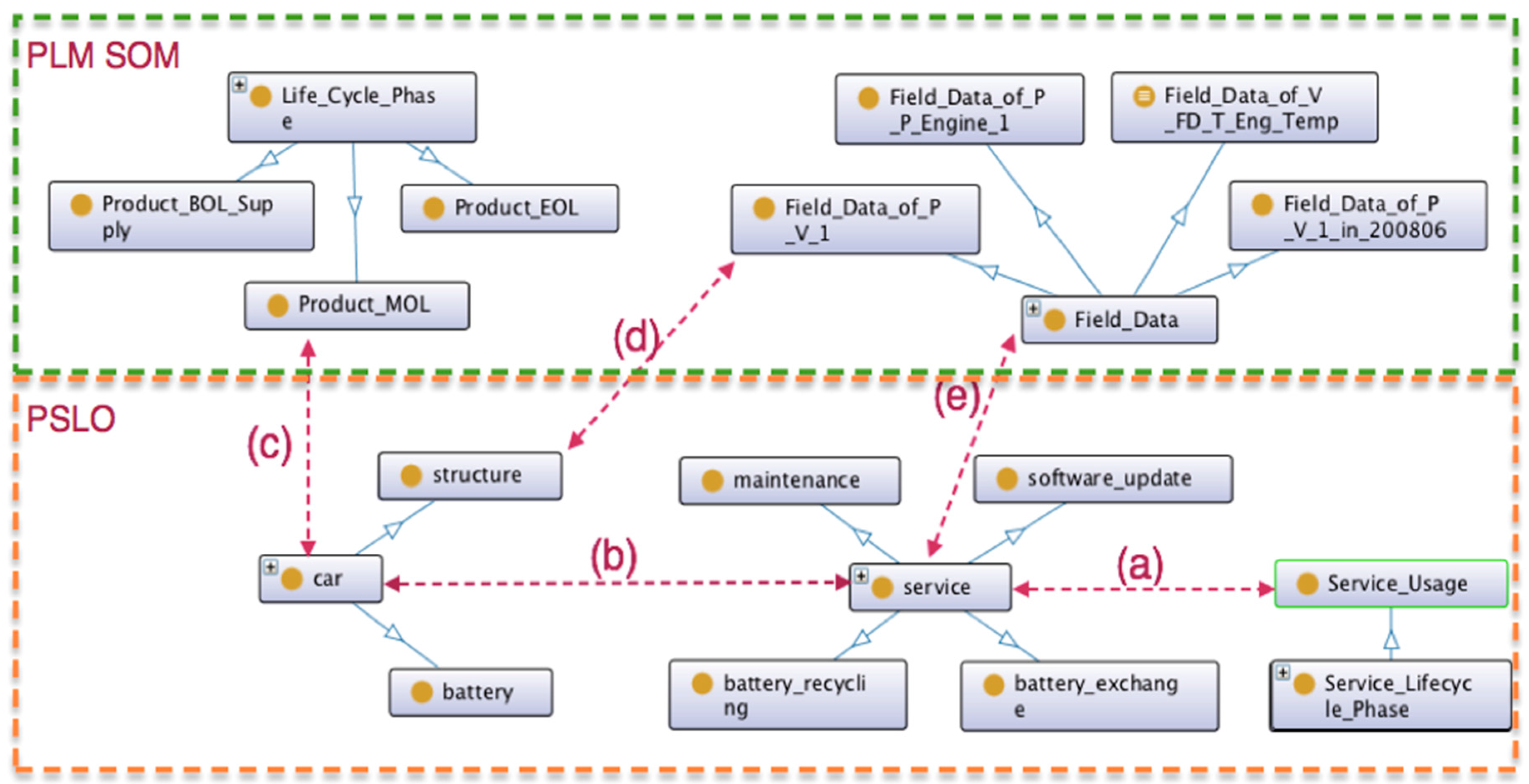
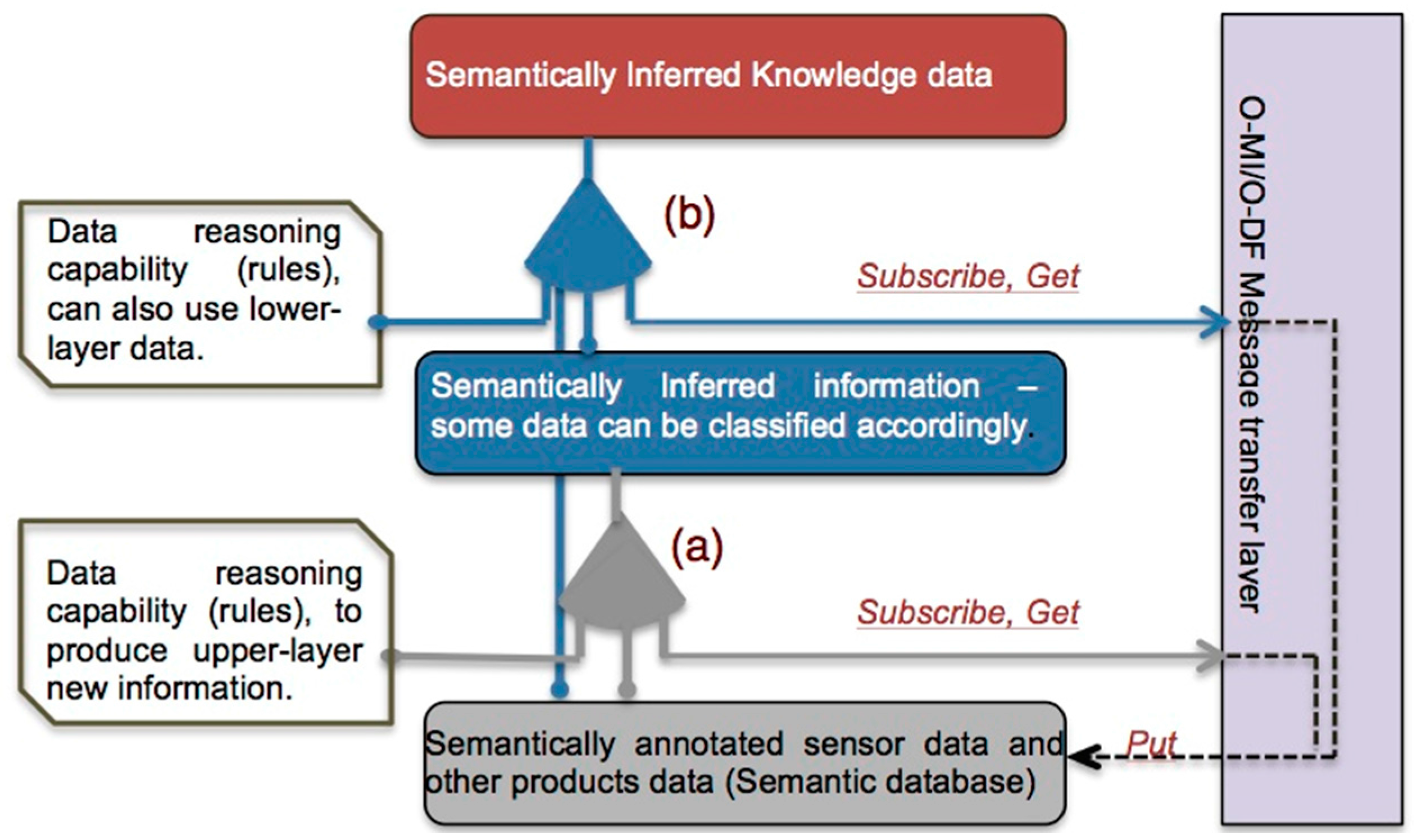







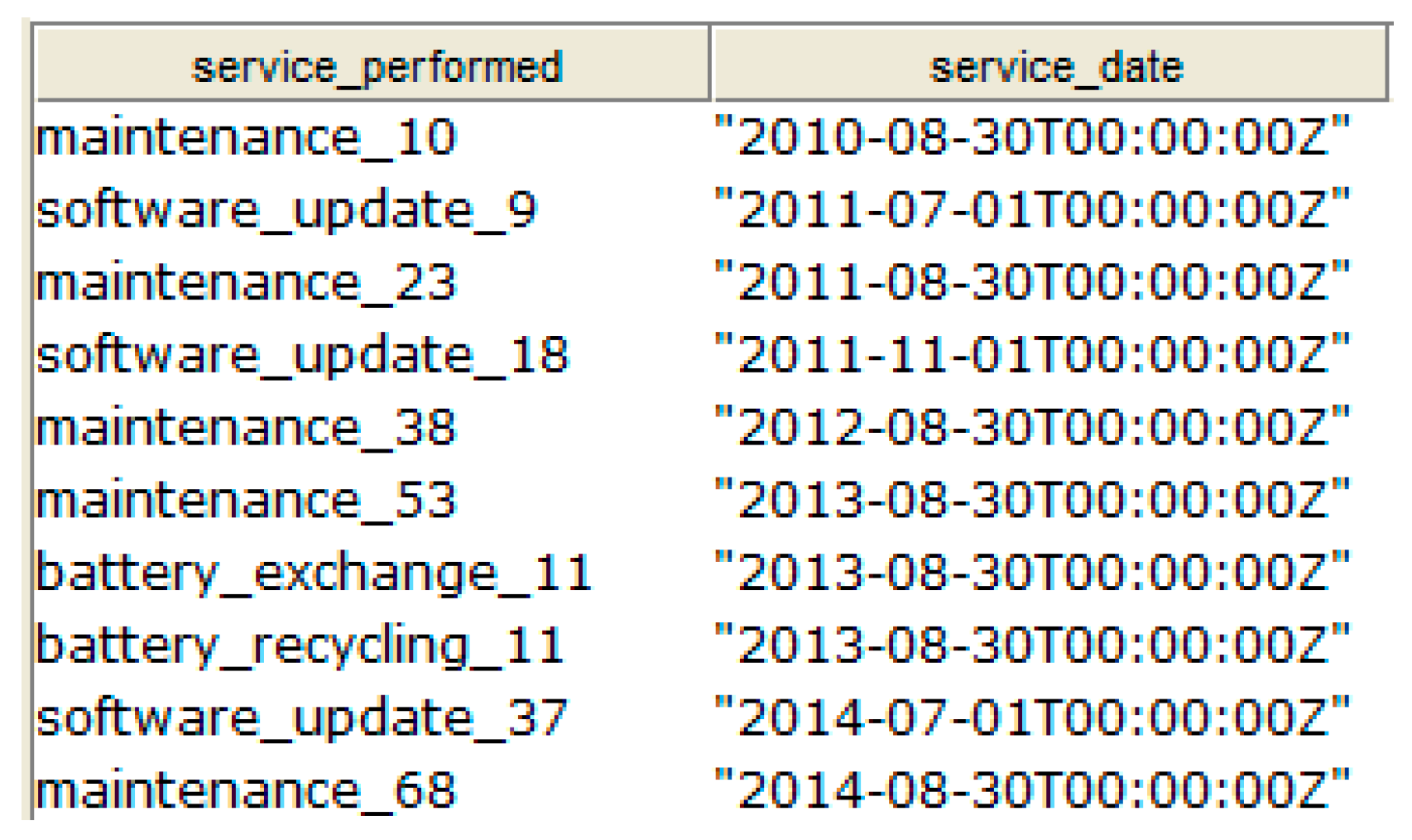



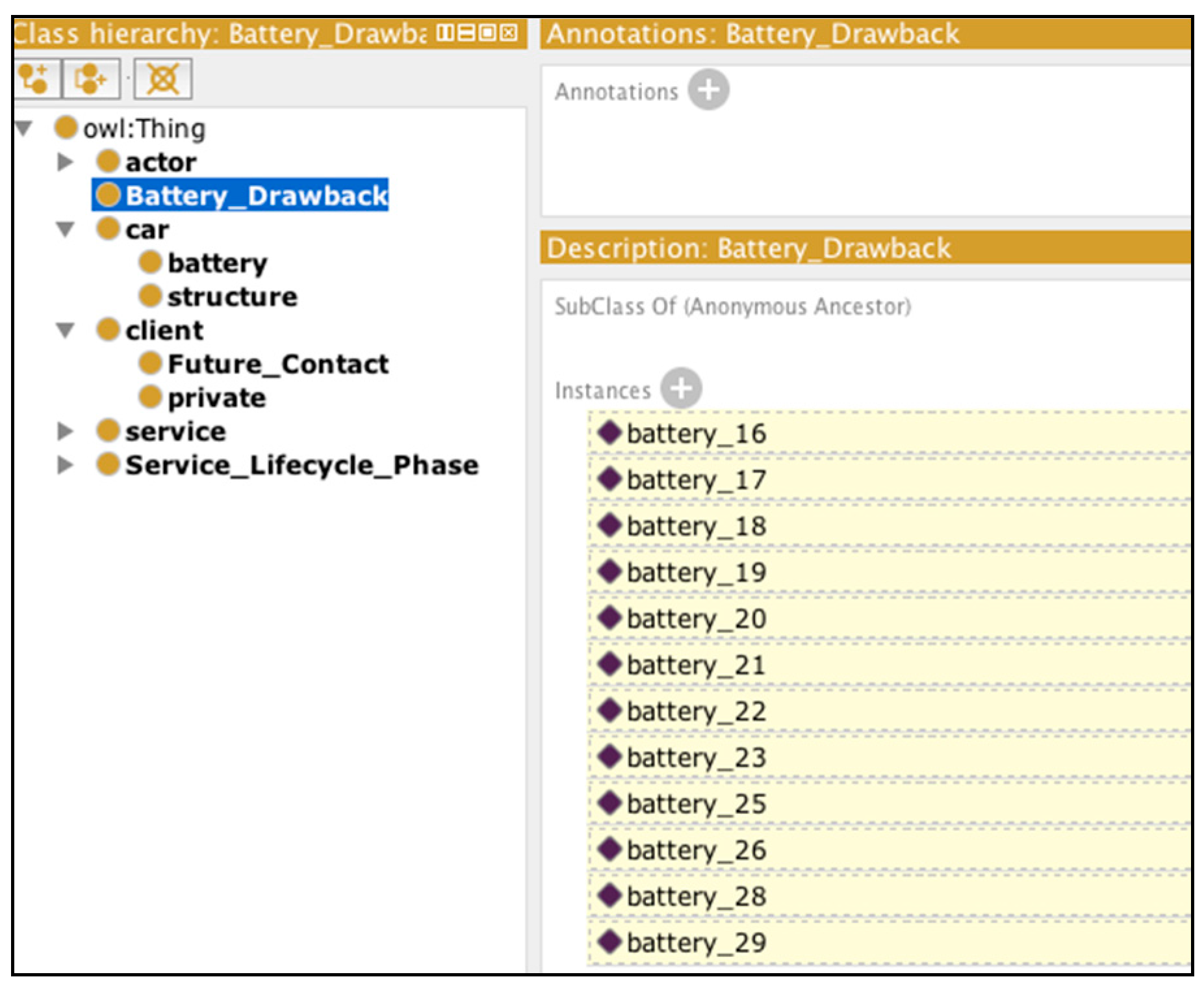
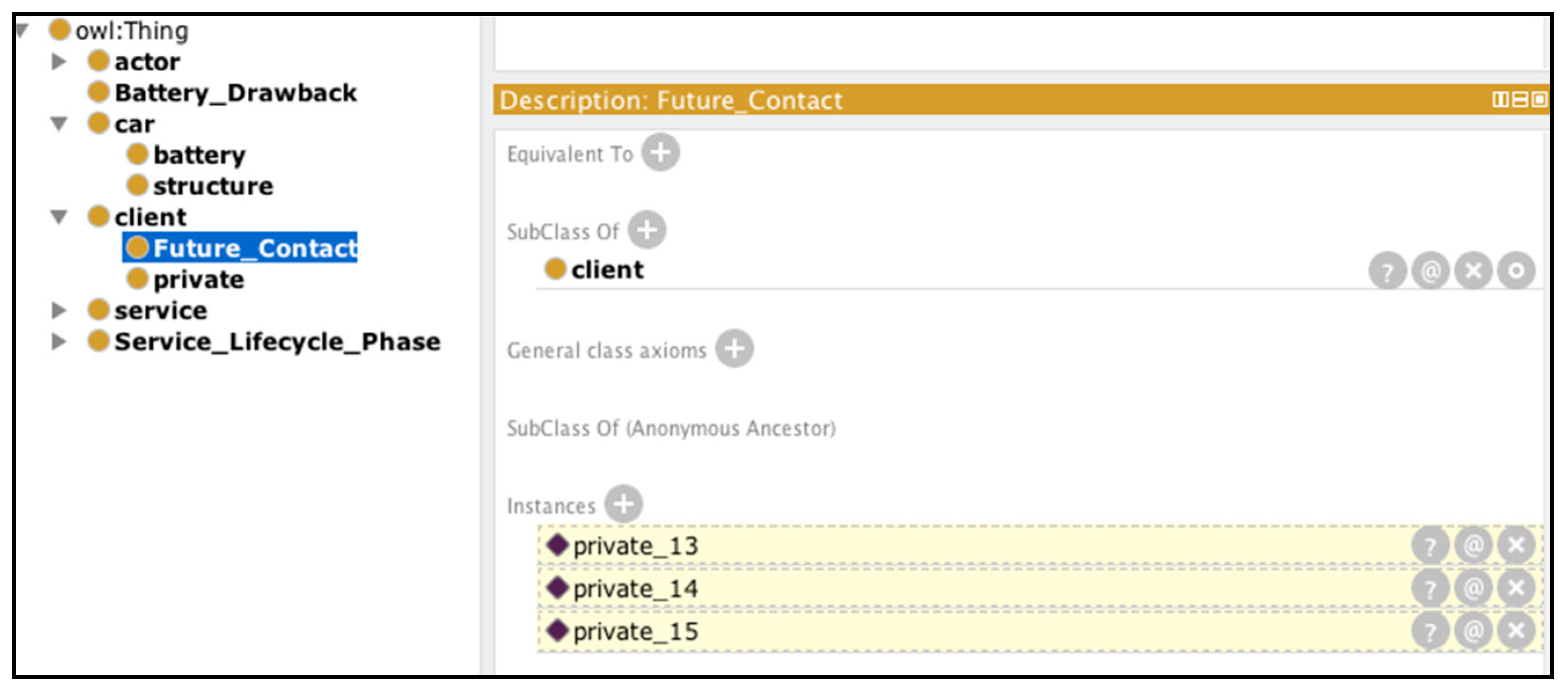
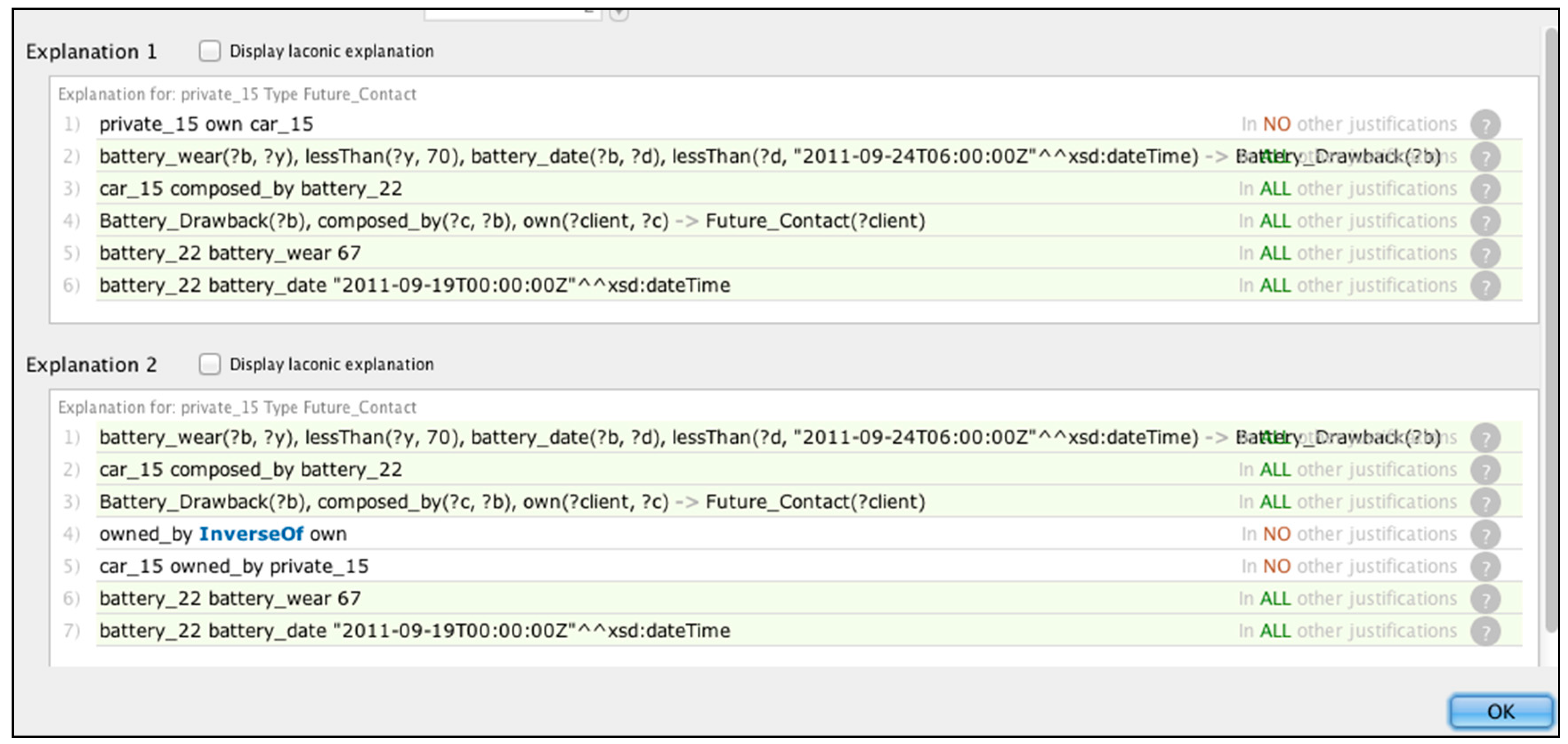
| Definition | Approach or Methodology to PSS | |
|---|---|---|
| [8] | Product service: an integrated combination of tangible products and intangible services | Give the capability to offer a flexible value proposition to customers throughout the lifetime of a product |
| PSS: social systems that enhance social and economic value received by each actor in the network through the mutual provision of a PS | ||
| [9] | PSS: a marketable set of products and services capable of jointly fulfilling a user’s need | Theoretical framework for PSS composed of five key elements: 1. Products, services and their combinations; 2. Services at the point of sales; 3. Different concepts of product use; 4. Maintenance services; 5. Revalorisation services |
| [10] | Product-service: composed proposition of tangible products and intangible services designed to optimize the product use and increase the value | Smart maintenance service for strategic progress of PSS from product-oriented to a service-oriented lifecycle |
| [11] | PSS: definition based on [9] referenced | Framework integrating technical product with non-physical service by an automated design processes |
| [12] | PSS: a system of products, services, supporting networks and infrastructures that are designed to be competitive, satisfy customer needs and have a lower environmental impact than traditional business models, according to [9] | Classification of PSS model based on three dimensions: Product-oriented services, Use-oriented services, Result-oriented services |
| [13] | PSS: an integrated product and service offering that delivers value in use to the customer | Several methodologies presented including Fast-Track Total Care design process, Heterogeneous IPS concept modelling, and Dimensions of PSS Design |
© 2016 by the authors; licensee MDPI, Basel, Switzerland. This article is an open access article distributed under the terms and conditions of the Creative Commons Attribution (CC-BY) license (http://creativecommons.org/licenses/by/4.0/).
Share and Cite
Yoo, M.-J.; Grozel, C.; Kiritsis, D. Closed-Loop Lifecycle Management of Service and Product in the Internet of Things: Semantic Framework for Knowledge Integration. Sensors 2016, 16, 1053. https://doi.org/10.3390/s16071053
Yoo M-J, Grozel C, Kiritsis D. Closed-Loop Lifecycle Management of Service and Product in the Internet of Things: Semantic Framework for Knowledge Integration. Sensors. 2016; 16(7):1053. https://doi.org/10.3390/s16071053
Chicago/Turabian StyleYoo, Min-Jung, Clément Grozel, and Dimitris Kiritsis. 2016. "Closed-Loop Lifecycle Management of Service and Product in the Internet of Things: Semantic Framework for Knowledge Integration" Sensors 16, no. 7: 1053. https://doi.org/10.3390/s16071053





